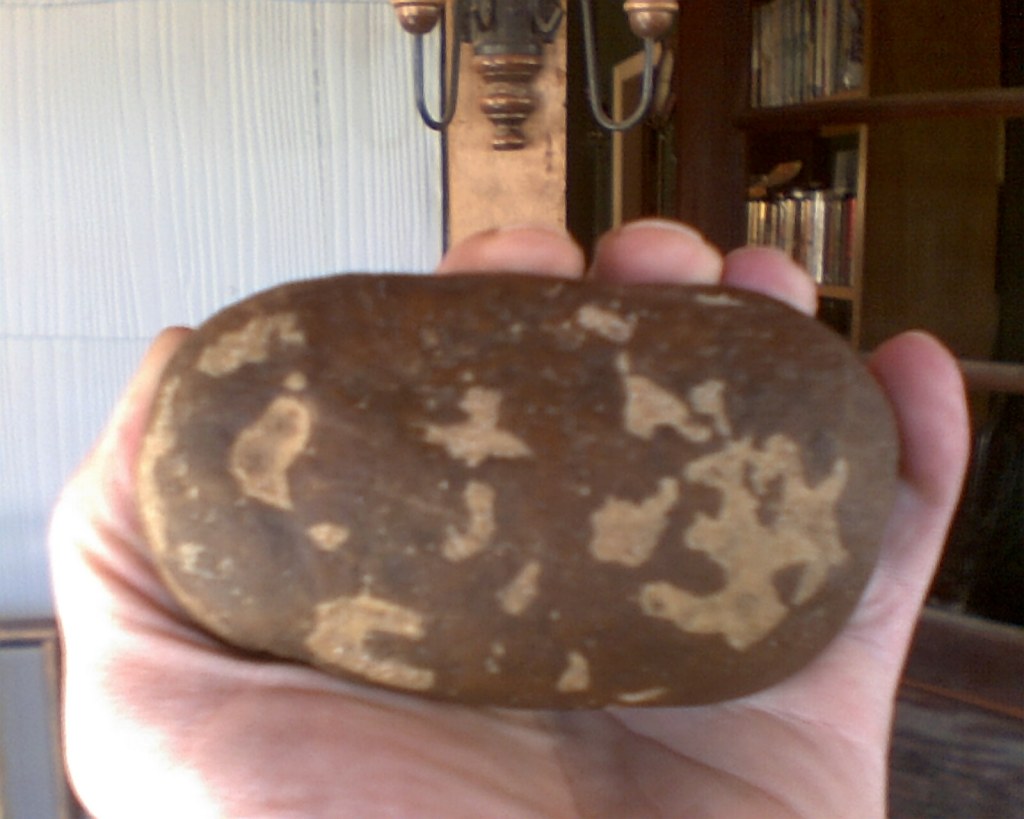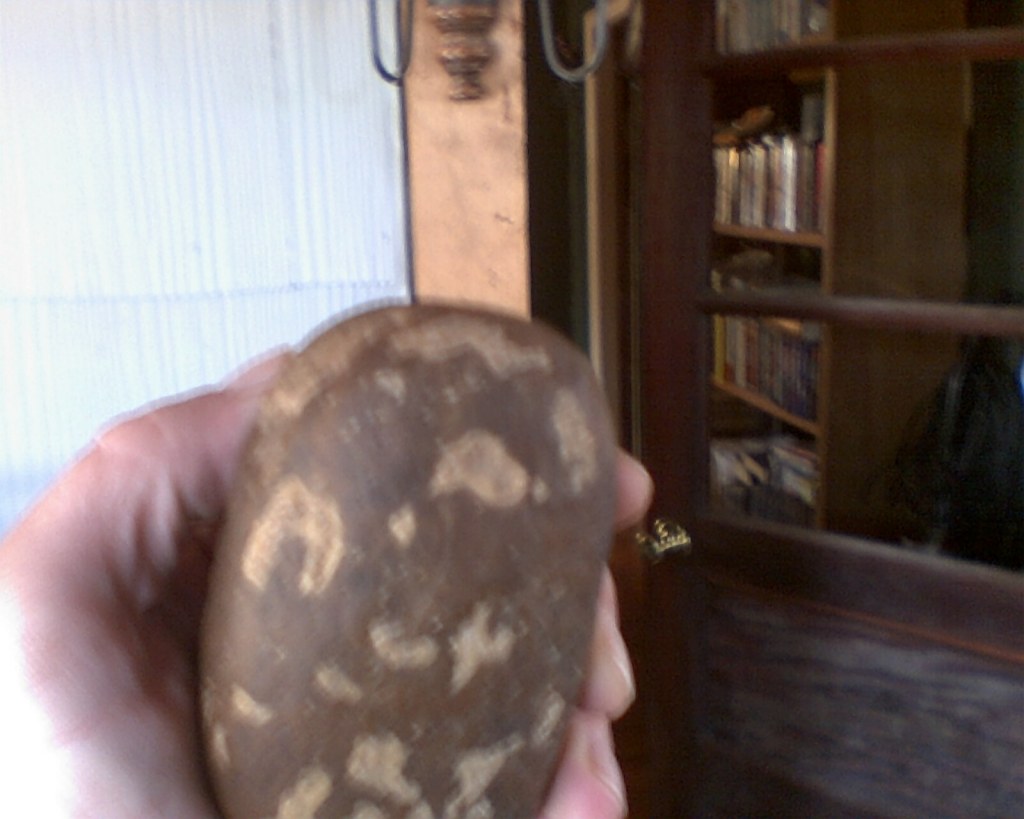
Back in December, Diego emailed me pictures of an interesting looking, rounded rock that has some lighter markings on it that look like pictures.
Diego wrote:
Hello Evelyn,My name is Diego, and since you like to study rocks, I do have one for you! I was told it was sediment that created the pictures on the rock.Is it possible? What would you do if you have found this rock? Any ideas would be most helpful. And do what you want with the pics.Enjoy the Holiday and the New Year. I am in no hurry for the answer, and if you need more pics, will send. Or if you like I will send it to you as long as you don’t break it! If this helps; at 60x it looks to be sand turned into glass.Thanks for your time.Sincerely,Diego
I wrote back to Diego to ask him for a little more information about his rock. Specifically, I wanted to know where he found the rock in order to obtain a little bit of regional context. Diego wrote back that he found the rock in Winona, Kansas. He says that the rock came from the bottom of a ~25 ft deep hole and that he picked up the rock when he was helping a friend repair some sewage lines. Diego has had the rock for 7-8 years and is fascinated by the light-colored patterns on the rock. He’s shown the rock to people over the years, and they’ve seen many things in the patterns, such as:
Clouds, face, sun/moon, cave/house/mountain, bird, worm and the last thing on the bottom the kids actually got that one. One said it was an angel, another said it was a dancer, and one boy said it was someone riding a dog! Who knows though, all say it looks like a bear.
Diego is curious if some geologists can help identify his rock. I thought I’d write down my ideas here and then perhaps some other geologists can write down their ideas in the comments.
Here are some more pictures of the rock:



Diego, I appreciate you willingness to send me the rock, but I don’t think that will be necessary. However, I’m afraid that in order to truly identify your rock it may be necessary to break it. There appears to be a weathering rind on the rock, and in all honesty I’m not sure I can fully identify it without seeing the less-weathered interior. If you’re willing to break even a small piece off the rock to expose the interior, that would be very helpful!
With the pictures I have so far, though, let me try to do some basic identification. As always, let me start with the basic identification questions. Then I’ll move on to a few more specific questions.
Is the rock natural or manmade?
Based on the morphology and weathering of the rock, I’d say that this is a natural rock. The rounding of the rock gives me a clue that this rock has spent some time in a stream or other body of water, which eroded and smoothed the rock.
Is the rock igneous, sedimentary, or metamorphic?
Because of the brown weathering rind, I’m afraid I cannot definitely identify the rock type. Many different types of rocks develop similar-looking brown weathering rinds. If I had to guess, however, I’d say that this is either a fine-grained igneous rock such as basalt or some type of sedimentary rock.
So, what is the rock?
The rock is a rounded cobble which spent some time in a stream or other body of water. The rock has also clearly been weathered producing a brown weathering rind. The rock is probably igneous or sedimentary.
What are those strange markings on the rock?
I’m actually not completely sure. Diego, perhaps you could send through some slightly higher resolution photographs which are close-ups of those lighter patches? Those markings could be places where the lighter interior of the rock is being revealed or, perhaps, they are places where a secondary infill has been deposited. One interesting thing I noticed is that the lighter markings are absent from at least one side of the rock.
Why do those strange markings look like pictures?
I believe that those markings are natural rather than manmade. The fact that the markings look like pictures is probably just a result of the pattern-seeking nature of the human brain. The human brain looks for patterns everywhere– that’s why people see, for instance, an image of the Virgin Mary in a grilled cheese sandwich. Personally, on quiet days I like looking for patterns in the clouds– it’s remarkable what patterns the human mind can detect in natural objects such as clouds.
To summarize, this mystery rock is still somewhat of a mystery. We know that the rock is a cobble which spent some time being rounded and weathered in a stream or other body of water. The rock also appears to have a brown weathering rind that obscures identification of the specific rock type. The light-colored markings on the rock are most likely natural, but I’d have to see a higher-resolution photograph or the rock in person in order to identify them further.
To help further identification of the rock, here are some things which Diego can do:
1. Break off a small piece of the rock or saw the rock in half, if he’s willing. This will be the best way to further identify the rock.
2. Take some higher resolution pictures of the rock, particularly of the light-colored areas.
3. Show the rock to a geologist in person. Are there any geologists in the Kansas area willing to look at Diego’s rock?
That’s all I have to say. Diego, if you’re willing to break your rock and then send me pictures– or even just send higher-resolution pictures of the rock’s surface– I’d be happy to devote another post to this mystery rock.
What do other geologist think about this rock? Also, if you want to see any of my previous mystery rock posts, you can find them here.

Oh, also feel free to post what you think you see in the lighter-colored patches! I see a horseshoe, a bird, and a stegosaurus :-).
LikeLike
I have a rock that looks similar from the Oregon coast. The big difference is that mine doesn’t have a weathering rind. It’s grey, but the white inclusions are more uniform. So, my first thought is that the mystery rock is probably a weathered sandstone with some sort of limestone inclusion. Maybe it’s not native to the area in which it was found? That’s just speculation on my part though…
LikeLike
I think you’ve got a prime example of what’s commonly (and ruefully) referred to as an ‘Irish potato’.
LikeLike
Can you explain further, Ron?
….I don’t get it 😦
LikeLike
Oh, I get it… the rock looks like a potato. 🙂 I thought I was missing some essential geological terminology.
LikeLike
During the Irish potato famine of the late 1840s the potato crop (a tuber) failed catastrophically in a way that meant that the only things resembling potatoes that farmers could pull from the ground were rocks (that often resembled potatoes, as this one does). The nutritional value of rocks is considerably less than that of potatoes, and the misery that ensued led to this rueful phrase.
LikeLike
Alright, now on a more serious note since I’ve just seen the Kansas connection, I suspect one of two possible origins for this rock. Most likely this is a cobble out of the Tertiary Ogallala Formation, a clastic wedge shed off the Rocky Mountains as they were uplifting. There’s also a possibility, because of the railroad that runs through Winona, that this is a sample imported anthropogenically for railroad ballast, though given the specific location you describe, I’d lean heavily toward the Ogallala interpretation.
LikeLike
Fun! The photos aren’t sharp enough to draw any firm conclusions, but I can think of several scenarios that could produce a rock like this:
1) The light spots could be a surface deposit of, say, calcium carbonate (caliche). The fact that the spots seem to be only on one side supports this idea, as–at least where I live–caliche tends to accumulate on the bottoms of rocks that are buried in soil, due to the downward percolation of water above the water table. If this were the case, the light spots should be soluble in vinegar, and/or able to be scraped off the surface with a steel scraper.
2) The light spots could be angular clasts of some sort, embedded in the rock; e.g. intraclasts or fossil fragments floating in a darker limestone mud matrix. If this were the case I wouldn’t really expect them to appear only on one side of the rock, but it’s possible if that side happened to coincide with a relatively thin lag surface or a bed contact.
3) The light spots could be a diagenetic artifact: perhaps they represent a contrast in porosity/permeability, where some dark mineral permeated most of the rock matrix but left these relatively dense or impermeable patches unstained.
4) A similar but opposite scenario to 3, in which the dark matrix is the original colour, but the light spots have been selectively “bleached” due to their greater porosity and permeability, or some subtle mineralogical contrast.
5) A masking effect: it has already been suggested that the dark colour is a weathering rind. Perhaps contact with relatively denser patches of soil prevented complete formation of the rind, leaving a few irregular patches showing the natural, lighter colour of the rock’s interior.
I agree with others that breaking or cutting the rock would test the likelihood of some of these scenarios.
LikeLike
Great ideas, Howard! Thanks!
LikeLike
I think it possibly could just be a real potato left too long in the potato bin. Only without the squiggly arms growing out.
LikeLike
I’m going with Howard #1 suggestion, simply because I have seen so many that look like this. Notice how the light spots are concentrated in low areas where they have not been worn away.
LikeLike